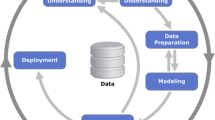Abstract
The dropout of university students has been a factor of concern for educational institutions, affecting various aspects such as the institution’s reputation and funding and rankings. For this reason, it is essential to identify which students are at risk . In this study, algorithms based on decision trees and random forests are proposed to solve these problems using real data from 331 students from the University of Trásos-Montes and Alto Douro. In this work with these learning algorithms together with the training strategies , we managed to obtain an 89% forecast of students who may abandon their studies based on the evaluations of both semesters related to the first year and personal data.
Access this chapter
Tax calculation will be finalised at checkout
Purchases are for personal use only
Similar content being viewed by others
References
Engrá cia, P., Baptista, J: Percursos no ensino superior: situação após quatro anos dos alunos inscritos em licenciaturas de três anos. Lisboa: Direção-Geral de Estatísticas da Educação e Ciência (2018)
Breiman, L.: Random forests. Mach. Learn. 45(1), 5–32 (2001)
Vandamme, J.-P., Meskens, N., Superby, J.-F.: Predicting academic performance by data mining methods. Educ. Econ. 15(4), 405–419 (2007)
Thai Nghe, N., Janecek, P., Haddawy, P.: A comparative analysis oftechniques for predicting academic performance. In: 2007 37th Annual Frontiers in Education Conference-Global Engineering: Knowledge without Borders, Opportunities without Passports, pp. T2G–7. IEEE (2007)
Azmi, M.S.B.M., Paris, I.H.B.M.: Academic performance prediction based on voting technique. In: 2011 IEEE 3rd International Conference on Communication Software and Networks, pp. 24–27. IEEE (2011)
Kotsiantis, S.B., Pierrakeas, C.J., Pintelas, P.E.: Preventing student dropout in distance learning using machine learning techniques. In: Palade, V., Howlett, R.J., Jain, L. (eds.) Knowledge-Based Intelligent Information and Engineering Systems, pp. 267–274. Springer Berlin Heidelberg, Berlin, Heidelberg (2003). https://doi.org/10.1007/978-3-540-45226-3_37
Plagge, M.: Using artificial neural networks to predict first-year traditional students second year retention rates. In: Proceedings of the 51st ACM Southeast Conference, pp. 1–5 (2013)
Delen, D.: A comparative analysis of machine learning techniques for student retention management. Decis. Support Syst. 49(4), 498–506 (2010)
Bogard, M., Helbig, T., Huff, G., James. C.: A comparison of empirical models for predicting student retention. White paper. Office of Institutional Research, Western Kentucky University (2011)
Márquez-Vera, C., Cano, A., Romero, C., Ventura, S.: Predicting student failure at school using genetic programming and different data mining approaches with high dimensional and imbalanced data. Appl. Intell. 38(3), 315–330 (2013)
Tinto, V.: Dropout from higher education: a theoretical synthesis of recent research. Rev. Educ. Res. 45(1), 89–125 (1975)
Quinlan, J.R.: Generating production rules from decision trees. In: ijcai, vol. 87, pp. 304–307. Citeseer (1987)
Pal, M.: Random forest classifier for remote sensing classification. Int. J. Remote Sens. 26(1), 217–222 (2005)
Hassan, S.U., Akram, A., Haddawy, P.: Identifying important citations using contextual information from full text. In: 2017 ACM/IEEE Joint Conference on Digital Libraries (JCDL), pp. 1–8. IEEE (2017)
Pedregosa, F., et al.: Scikit-learn: machine learning in Python. J. Mach. Learn. Res. 12, 2825–2830 (2011)
Kohavi, R., et al.: A study of cross-validation and bootstrap for accuracy estimationand model selection. In: Ijcai, Montreal, Canada, vol. 14, pp. 1137–1145 (1995)
Author information
Authors and Affiliations
Editor information
Editors and Affiliations
Rights and permissions
Copyright information
© 2021 Springer Nature Switzerland AG
About this paper
Cite this paper
Silva, B., Pires, E.J.S., Reis, A., de Moura Oliveira, P.B., Barroso, J. (2021). Students Drop Out Trends: A University Study. In: Reis, A., Barroso, J., Lopes, J.B., Mikropoulos, T., Fan, CW. (eds) Technology and Innovation in Learning, Teaching and Education. TECH-EDU 2020. Communications in Computer and Information Science, vol 1384. Springer, Cham. https://doi.org/10.1007/978-3-030-73988-1_36
Download citation
DOI: https://doi.org/10.1007/978-3-030-73988-1_36
Published:
Publisher Name: Springer, Cham
Print ISBN: 978-3-030-73987-4
Online ISBN: 978-3-030-73988-1
eBook Packages: Computer ScienceComputer Science (R0)




